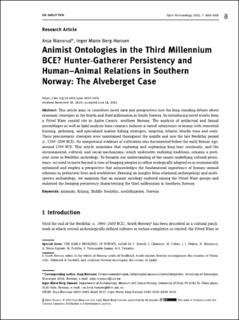| dc.contributor.author | Mansrud, Anja | |
| dc.contributor.author | Berg-Hansen, Inger Marie | |
| dc.coverage.spatial | Norway, Agder | en_US |
| dc.date.accessioned | 2021-10-18T10:57:19Z | |
| dc.date.available | 2021-10-18T10:57:19Z | |
| dc.date.created | 2021-09-22T13:29:15Z | |
| dc.date.issued | 2021-08 | |
| dc.identifier.citation | Mansrud, A., Berg-Hansen, I.M. (2021) Animist Ontologies in the Third Millennium BCE? Hunter-Gatherer Persistency and Human-Animal Relations in Southern Norway: The Alveberget Case. Open Archaeology, 7 (1), 868-888. | en_US |
| dc.identifier.issn | 2300-6560 | |
| dc.identifier.uri | https://hdl.handle.net/11250/2823660 | |
| dc.description.abstract | This article aims to contribute novel data and perspectives into the long-standing debate about economic strategies in the fourth and third millennium in South Norway, by introducing novel results from a Pitted Ware coastal site in Agder County, southern Norway. The analysis of artifactual and faunal assemblages as well as lipid analysis from ceramics indicate a varied subsistence economy with terrestrial hunting, gathering, and specialized marine fishing strategies, targeting Atlantic bluefin tuna and seals. These procurement strategies were maintained throughout the middle and into the late Neolithic period (c. 3300–2200 BCE). No unequivocal evidence of cultivation was documented before the early Bronze Age, around 1700 BCE. This article maintains that exploring and explaining long-time continuity, and the environmental, cultural, and social mechanisms, which underwrite enduring traditions, remains a pertinent issue in Neolithic archeology. To broaden our understanding of the causes underlying cultural persistence, we need to move beyond a view of foraging peoples as either ecologically adapted or as economically optimized and employ a perspective that acknowledges the fundamental importance of human–animal relations in prehistoric lives and worldviews. Drawing on insights from relational anthropology and multi-species archaeology, we maintain that an animist ontology endured among the Pitted Ware groups and endorsed the foraging persistency characterizing the third millennium in Southern Norway. | en_US |
| dc.language.iso | eng | en_US |
| dc.publisher | Walter de Gruyter GmbH | en_US |
| dc.rights | Navngivelse 4.0 Internasjonal | * |
| dc.rights.uri | http://creativecommons.org/licenses/by/4.0/deed.no | * |
| dc.subject | arkeologi | en_US |
| dc.subject | nordisk arkeologi | en_US |
| dc.subject | neolitikum | en_US |
| dc.subject | animisme | en_US |
| dc.title | Animist Ontologies in the Third Millennium BCE? Hunter-Gatherer Persistency and Human-Animal Relations in Southern Norway: The Alveberget Case | en_US |
| dc.type | Peer reviewed | en_US |
| dc.type | Journal article | en_US |
| dc.description.version | publishedVersion | en_US |
| dc.rights.holder | © 2021 Anja Mansrud and Inger Marie Berg-Hansen | en_US |
| dc.subject.nsi | VDP::Humaniora: 000::Arkeologi: 090::Nordisk arkeologi: 091 | en_US |
| dc.source.pagenumber | 868-888 | en_US |
| dc.source.volume | 7 | en_US |
| dc.source.journal | Open Archaeology | en_US |
| dc.source.issue | 1 | en_US |
| dc.identifier.doi | 10.1515/opar-2020-0176 | |
| dc.identifier.cristin | 1937148 | |
| cristin.ispublished | true | |
| cristin.fulltext | original | |
| cristin.qualitycode | 1 | |

